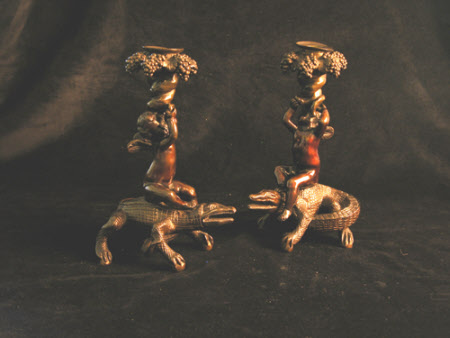Candlestick, in the form of a putto holding a cornucopia, riding upon a crocodile
French School or British (English) School
Category
Art / Sculpture
Date
c. 1810 - 1820
Materials
Bronze
Measurements
216 x 101 x 134 mm
Order this imageCollection
Anglesey Abbey, Cambridgeshire
NT 515104.2
Summary
Bronze, candlestick in the form of a putto holding a cornucopia, riding upon a crocodile, French or British School, c. 1810-20. A bronze candlestick, probably made in France or in Britain c. 1810-20, depicting a naked winged putto seated on a crocodile, which twists its tail and stands upon four integral ball-feet. The putto holds a cornucopia overflowing with grapes, which forms the candleholder. The top section, with the putto and the cornucopia, was separately cast from the crocodile, and the piece assembled by means of a rod that runs from the candle holder through the bodies of the putto and the crocodile, and is fixed with a screw on the underside of the base. A pair to 515104.1. Although slightly less well finished than its companion, the figure of the putto in particular is finely worked, the flesh surfaces polished with a wire brush, the hair and wings gently matted. The surface has a lacquer patination.
Full description
These candlesticks are a strange combination of an ostensibly fierce and rather lizard-like crocodile, a highly refined putto figure and a heavy, gelatinous cornucopia, which appears almost to be slipping out of the child’s grasp. As functional utensils, they are well-designed, with the four well-spaced feet of the crocodile providing stability, whilst the object is also easy to pick up by the figure of the boy. Inventive but slightly bizarre, the model is characteristic of decorative arts in the early nineteenth-century Regency period. Well-cast and -finished, the two candlesticks were probably made in Britain, presumably London or Birmingham, although it is not impossible that they were produced in another European centre, most probably Paris. An example of the model in gilt- bronze appeared in a sale organised by the dealer and auctioneer in Paris in 1857, described as Italian 16th-century work (Catalogue d’une jolie Collection d’Objets d’Art et d’Antiquité, Paris, Drouot, 30 April-4 May 1857, p. 23, lot 132, ‘Flambeau formé d’un amour assis sur un crocodile, et soutenant une corne d’abondance. Bronze doré italien, d’une grande légèreté. XVIe siècle. H. 21 c.’). The original model was probably intended for casting in silver. Indeed, an identical pair of candlesticks in silver was formerly at Anglesey Abbey (NT 516551), but they were stolen from the house in November 2006. Unfortunately, no record survives of whether the silver pair had marks that could have helped identify the maker and place of production. The candlesticks may, albeit on a much lesser scale, be compared with some of the spectacular figurative pieces in the ‘Grand Service’, executed by Rundell, Bridge and Rundell for the Prince Regent, later King George IV, and designed by the London silversmith Paul Storr (1770-1844) and other leading artists such as John Flaxman (Kate Heard and Kathryn Jones, eds., George IV. Art and Spectacle, London 2019, pp. 204-06). These include the Mercury and Bacchus Candelabrum designed by Flaxman (1809-17, RCIN 51977; George IV. Art and Spectacle, p. 205, fig. 15.9) or the four elaborate centrepieces designed by Storr (1812-21; for one, RCIN 51981). This helps to confirm a dating around the decade 1810-20. Examples in bronze appear quite frequently on the art market, sometimes with the crocodiles and candleholders gilded. Two have been sold in recent years by Christie’s: a gilt-bronze pair at Christie’s East, New York in 1994, and a single example, also gilded, in the 1999 sale of the Alexander Collection in New York, at which it was catalogued as French, c. 1825 (The Alexander Collection: French Furniture, Boxes & Porcelain, Christie’s New York, 30 April 1999, lot 11). Other examples formerly on the market include an ungilded pair with Blanchard Collective of Marlborough (Ref. OBE- 5213), and another with Mytton Antiques of Shrewsbury (Ref. 21447). A bronze version was formerly in the Dent collection, Allentown, Pennsylvania, where it was catalogued as French eighteenth century (The Charles C. Dent Collection of Renaissance Bronzes and other Statuary. Volume 1, Allentown 1967, no. 140). Jeremy Warren 2020
Provenance
Acquired by Huttleston Rogers Broughton, 1st Lord Fairhaven (1896-1966), between 1932 and 1940; listed in the Anglesey Abbey inventory of 1940, p. 54, Windsor Room, valued at £12 the pair; bequeathed to the National Trust by Lord Fairhaven in 1966 with the house and the rest of its contents.
Credit line
Anglesey Abbey, The Fairhaven Collection (National Trust)
Makers and roles
French School or British (English) School, maker
References
'Anglesey Abbey, Lode, Cambridgeshire. An Inventory and Valuation of Furniture, Books, Ornamental Items & Household Effects .. prepared for Insurance Purposes’, Turner, Lord and Ransom, April 1940, p. 54. Christie, Manson & Woods 1971: The National Trust, Anglesey Abbey, Cambridge. Inventory: Furniture, Textiles, Porcelain, Bronzes, Sculpture and Garden Ornaments’, 1971, p. 130.

